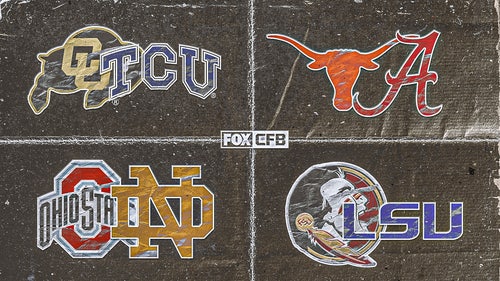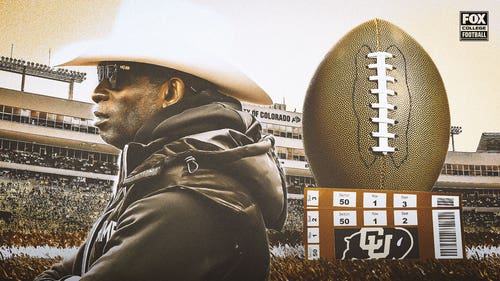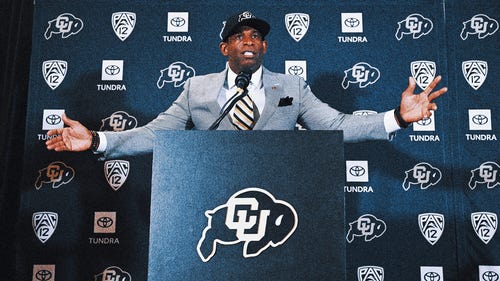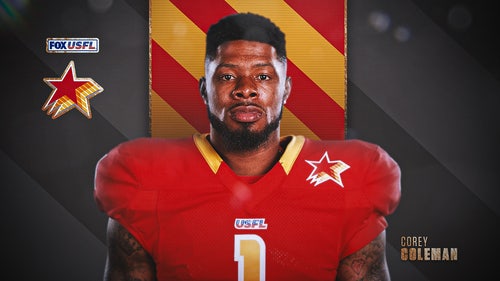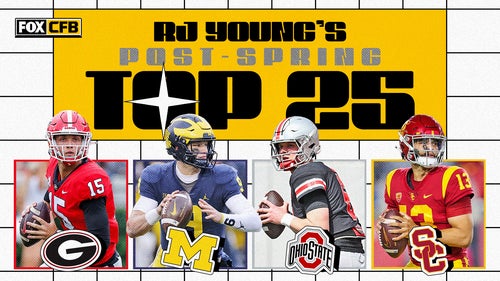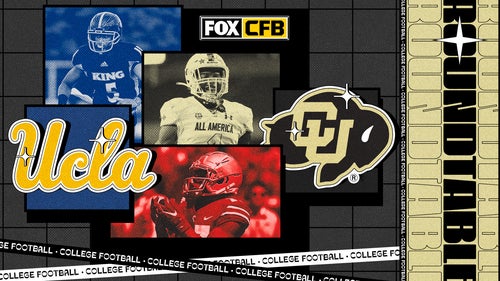

Prepping for the NFL: How Pac-12 coaches compare at developing offensive stars
Editor's note: This is part of an ongoing series on how college coaches fair at developing players for the NFL. Check out previous stories on Big Ten offensive players and Big Ten defensive players.
Fresh off a football campaign where half the Pac-12 finished in the top 25 — and ahead of an upcoming season that could be among the most interesting in recent memory — the conference finds itself in a state of transition.
One simply has to look at a list of the Pac-12 head coaches to understand that.
Big names like Lincoln Riley and Chip Kelly are transitioning out, embarking on one last, awkward West Coast swing before joining the Big Ten. The dean of the group, Kyle Whittingham, has shown the benefits that can come with conference realignment and sits with the two most recent conference football championships outside his office. Fellow veterans (relatively speaking) like Justin Wilcox and Jonathan Smith continue to go about their business significantly under the radar, while the vast majority of those who remain are young, energetic, and without much of a track record to lean on.
Despite all that, all understand that college football remains mostly driven by the underlying principle of having better players than your opponent. Before you even get to the Xs and Os that are on display each Saturday, having the Jimmys and the Joes tends to be the best prognosticator of success on the field.
But just how good are coaches when it comes to finding all those good players and, well, coaching them up?
Following the 2023 NFL Draft, FOX Sports pulled decades of recruiting data and looked into just how productive (or not) each active Power 5 coach was at both recruiting and developing players — and at what positions — when it came to the ultimate eye in the sky of the NFL.
More stories on ‘Prepping for the NFL’
[Related: How Big Ten coaches fare at producing offensive talent]
In the third part of a series about developing talent in college football, here's a look at how some of the coaches in the Pac-12 have fared over the years in terms of best producing offensive talent:
Quarterbacks
The Best: Lincoln Riley, USC
Others of note: Chip Kelly, UCLA; Jonathan Smith, Oregon State
Surprisingly disappointing: Kyle Whittingham, Utah
For several years while at Oklahoma, Lincoln Riley's name would often come up whenever there was a head coaching opening at the NFL. Watch his offenses in Norman or, now in Los Angeles, and it wasn't hard to see why he would tick off the boxes for owners around the league. Peruse the list of draft picks he's coached and, well, the thought would be underscored.
Any discussion naturally starts with the quarterback position and just how good the Mike Leach protégé has been at producing them. Despite being in charge for just six seasons, Riley has produced a pair of No. 1 overall selections and a third who wound up becoming one of the highest-paid players in the league. By the time Spencer Rattler and potential 2024 No. 1 overall pick Caleb Williams conclude their college careers, every starter who has played the position under Riley will have been drafted.
The overall hit rate, which only has Ohio State's Ryan Day as a peer among active coaches, is impressive enough, but Riley takes things a step further when you consider he can claim that the median pick for signal-callers he's coached is the first overall pick of the draft. Not bad, and something that is unlikely to change going into next spring judging by what the Heisman Trophy winner — the coach's third under center — has shown.
Put it another way, Riley has had as many quarterbacks drafted No. 1 overall as the rest of the Pac-12 coaches in 2023 have had drafted period. The rest of the league is bound to change that stat significantly in 2024 and beyond, but it highlights just how good the USC coach has been with signal-callers as much as the fact that so many in charge of programs in the league are so early in their careers.
Indeed, there's not much data at the position beyond the cardinal and gold, but any assumptions you might have on some of the other offensive-minded head coaches generally ring true.
OSU's Jonathan Smith, for example, took a former two-star and junior college transfer in Jake Luton and got him drafted in the sixth round after just a few years in Corvallis. He'll have a good data point in the future on the other end of the development scale too — depending on what he does with ex-five-star DJ Uiagalelei during the 2023 season.
Then there's Chip Kelly, who is set to embark on his 10th season as a head coach in the college ranks but who has actually turned just one QB on his ledger fully from recruit to NFL player. That would be Dorian Thompson-Robinson, a signal-caller who was one of his earliest and most important recruits after arriving in Westwood. Kelly still has a decent eye for talent despite the overall number not being quite as robust as you would think, given that DTR has been a starter for five of the coach's nine seasons in charge.
He also recruited a certain Marcus Mariota during his time at Oregon, but left town before the Hawaiian could win the Heisman and go No. 2 overall.
The jury remains out for pretty much everybody else in the Pac-12 save one in the form of the nation's third-longest tenured head coach in Kyle Whittingham. Remarkably across 18 full seasons in charge, the Utah coach hasn't produced a single quarterback who has been drafted.
Compare that to peers on the active coaches list like Mike Gundy and Pat Fitzgerald, who each have had three taken in a similar time frame.
Whittingham can claim that Tyler Huntley did earn All-Pac-12 first-team honors while in Salt Lake City and has started multiple NFL games — but he did go undrafted. Perhaps current starter Cam Rising can break the streak, as there actually have been no Utah quarterbacks drafted since Alex Smith was turned into the No. 1 overall selection by current FOX Sports analyst Urban Meyer.
Running backs
The Best: Chip Kelly, UCLA
Others of note: Kyle Whittingham, Utah; Lincoln Riley, USC
It should come of little surprise that one of the coaches who has transformed college football's run game out of the spread would have a solid track record when it comes to producing running backs.
While Kelly is responsible for five of the 12 ball carriers drafted under Pac-12 coaches, what is more notable is how he has done in terms of both highly rated players and diamonds in the rough. Former four-stars like LaMichael James (at UO) and Zach Charbonnet (at UCLA) both wound up as second-round picks after putting up numbers in Kelly's offense, while ex-three-star Brittain Brown wound up as a late-round pick and Joshua Kelley went 112th overall despite arriving in Westwood as an FCS transfer and former two-star recruit.
Basically, as long as you weren't a running back connected to the NCAA case Kelly was involved in during his final years in Eugene, there's an extremely good chance you'll wind up in the league at some point.
Though not quite as good with highly ranked tailbacks, Utah's Whittingham has done well in terms of truly developing guys. While none of the three four-star RBs recruited by the head coach through 2020 heard their name in the draft, former three-star Zack Moss did wind up as a top-100 selection. The median pick for players at the position under Whittingham sits at a solid No. 129 overall and all four taken by the league had an average star-rating of less than three coming out of high school.
Perhaps most fascinating of all, the first draft class Whittingham can fully lay claim to all the way back in 2006 contains both a player recruited by Ron McBride and another player who is, all these years later, now the Utes' running backs coach in Quinton Ganther.
Tight ends
The Best: Chip Kelly, UCLA
Others of note: Jonathan Smith, Oregon State; Kyle Whittingham, Utah
Kelly has not only had more tight ends drafted than the rest of the Pac-12 coaches combined, but he would also rank third in the Big Ten ahead of notable names like Jim Harbaugh and James Franklin — and behind two others in Bret Bielema and Kirk Ferentz who have coached at least five more seasons in college.
Sixty percent of players at the position under Kelly have wound up as top-100 selections in the draft, too, and just about all of them have come from a diverse set of backgrounds before arriving in the league as a tight end. Back at Oregon, Ed Dickson was somebody who thrived in the coach's up-tempo system despite initially getting reps in Eugene on defense. The only pick after Kelly's first year in Westwood, Caleb Wilson, was originally recruited by several schools as a two-star quarterback before walking on at USC and eventually transferring across town. Current Denver Broncos pass-catcher Greg Dulcich wound up as a third-round pick after walking on, too.
Perhaps underscoring how Kelly looks for certain traits and body types to fit the mold of a pass-catcher who can put a hand in the dirt occasionally, very few players recruited out of high school at tight end under the coach actually made it through their college career at the position. The flip side is that a variety of walk-ons, transfers, or those who underwent a position change did end up having productive careers.
Having a weapon in both the run game and the passing attack is probably enhanced in offenses with plenty of NFL concepts like Kelly's or that of Oregon State's Smith. The latter recently turned Luke Musgrave from a three-star in his second recruiting class into a second-round selection in April and is the only other Pac-12 coach who can claim multiple players selected at tight end.
Whittingham should join that group given what he has coming back for 2023 but can claim an impressive development story after turning Dalton Kincaid into a first-rounder after the player initially walked on at an FCS program, transferred over to the Utes and blossomed into one of the best in the game this past season. Interestingly, though, Kincaid is just the second top-100 draft pick on offense under Whittingham since the program entered the Pac-12.
Wide receivers
The Best: Lincoln Riley, USC
Surprisingly disappointing: Kyle Whittingham, Utah; Chip Kelly, UCLA
The gap between Riley and his Pac-12 peers when it comes to the key elements of the passing game is, like at quarterback, enough to start comparing his track record more against some of his future Big Ten opponents than those he'll see in L.A. this year.
Just two others in the Pac-12 can even claim multiple receivers drafted as a head coach and all were taken in the fifth round or later. Riley, in sharp contrast, has seen his four wideouts go with a median pick of No. 24 overall in the first round.
Riley has had success up and down the recruiting rankings, too, from turning an undeniable talent like four-star CeeDee Lamb into a top-20 pick at Oklahoma, to plucking Marquise Brown out of a junior college after being unranked in high school and making him a first-rounder. Much like three-star-turned-first-round selection Jordan Addison was this past spring, the fact that a majority of wideouts under Riley have been transfers is also a notable caveat.
Elsewhere in the Pac-12, it is probably a bit disappointing that despite all the prolific offensive numbers that Kelly has put up over the years he has just two receivers selected — both ex-three-stars who wound up going on Day 3 of the draft. He seems to make up for it in other ways (see above with tight ends/running backs) but it's still a bit eye-opening at UCLA.
Whittingham is not known for the ability to develop offensive skill positions but does have longevity on his side, which makes having just three wideouts drafted out of the 45 he's recruited a bit surprising. In fact, sixth-round receiver Kaelin Clay in 2015 is the only other pass-catcher besides tight end Kincaid who has played during the Pac-12 era at Utah.
Offensive line
The Best: Lincoln Riley, USC
Others of note: Kyle Whittingham, Utah; Chip Kelly, UCLA
To the surprise of nobody who has watched Utah under Whittingham, defenders and players in the trenches have made up the bulk of who he has sent to the next level. This includes four offensive tackles and six interior offensive linemen over the years, with plenty of success stories to go with them.
Just recently, tackle Braeden Daniels was taken at No. 118 overall in the fourth round by Washington after starting his career as a three-star. Former four-star Garett Bolles developed nicely into a first-round pick while there are plenty of other two- (Zane Beadles) and three-stars (Tony Bergstrom) who wound up going in the top 100 as well.
Playing in a much different system, however, has still allowed Riley to come close to the overall numbers Whittingham has produced in a much shorter time frame.
In what should be given with an assist to veteran assistant Bill Bedenbaugh while together at Oklahoma, Riley had three offensive tackles go in the top 100 during his first two draft classes in Norman alone.
Further, half the linemen Riley has had drafted have gone in the top 100, and he's been a little more productive on the outside with tackles than he has been with guards — not something easily done. Four-stars have also wound up as draft picks at a higher rate than normal compared to most of his peers, but there are some good examples at the other end like former JUCO transfer Ben Powers and three-star Creed Humphrey becoming a Super Bowl champion recently after being taken in the second round.
Meanwhile, across town at UCLA, it perhaps emphasizes the differences in stylistic tendencies that the bulk of offensive linemen that Kelly has sent to the next level have been interior guys who were far more overlooked coming out of the prep ranks. Four-star OT Sean Rhyan did wind up as a top-100 pick, but that case looks more like an outlier so far given the change in approach one head coach takes in the trenches compared to others.
Bryan Fischer is a college football writer for FOX Sports. He has been covering college athletics for nearly two decades at outlets such as NBC Sports, CBS Sports, Yahoo! Sports and NFL.com among others. Follow him on Twitter at @BryanDFischer.
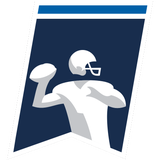







.jpg?downsize=56%3A*)































































.jpg?downsize=56%3A*)












































.jpg?downsize=56%3A*)
















.jpg?downsize=56%3A*)







